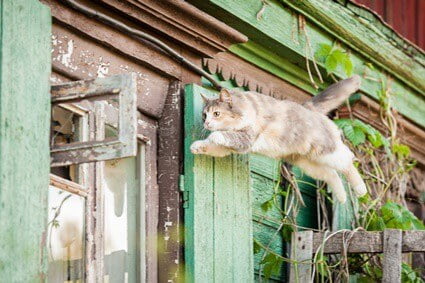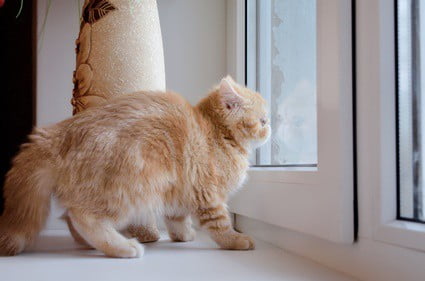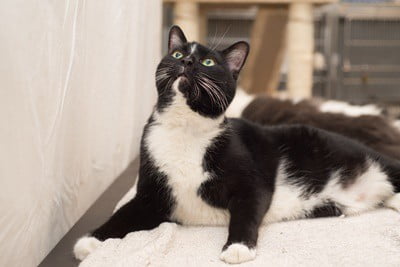Declawing a cat, also known as onychectomy, is a surgical procedure with lifelong consequences. Claws are a vital part of the feline anatomy and shouldn’t be amputated.
Declawing reduces a cat’s ability to defend itself from threats as claws are the primary form of self-defense. Without any claws, a cat relies on biting, which makes them feel more anxious. Declawing impacts a cat’s ability to walk, often leaving them with a limp. This means that fleeing from trouble is much harder.
Cats may look confident and fearless, but most are nervous by nature. Their ability to defend themselves when faced with danger is critical to keeping cats happy and healthy. This means that the decision to declaw a cat must be considered carefully as it’s not a procedure that can be reversed.
What is Declawing a Cat?
Declawing a cat is a controversial practice. Declawing is a surgical procedure known as an onychectomy that involves the physical removal of a cat’s claws. Unfortunately, it is not as simple as just filing down or trimming the nails.
A cat’s claws grow directly from the bones in the foot – they are not separate appendages. This makes declawing a cat comparative to amputating the tips of human fingers from the top knuckle.
There are two ways to declaw a cat:
- Cut the claws off with a scalpel or medical guillotine.
- Using laser surgery, such as a laser cutter, to declaw a cat.
Many people, including animal healthcare professionals, consider declawing a cruel and unnecessary process. As a result, it has been banned in many countries.
Declawing remains legal under U.S. federal law, but the state of New York and various other local authorities have outlawed the procedure. The American Veterinary Medical Association’s official policy discourages declawing, referring the decision to a veterinarian.
Why Are Cats Declawed?
The only justifiable reason for declawing is protecting a cat’s health. Tumors within the paw may leave declawing as the only way to save a cat’s life. Such cases are few and far between, though.
Destructive scratching behavior isn’t grounds for declawing. The Journal of Feline Medicine and Surgery describes scratching as a “normal expression of the feline ethogram.” Cats scratch for a variety of reasons. These include:
- Marking territory
- Trimming dead layers of claws
- Working off excess energy and frustration
- Stretching
- Self-defense
It is also one of the main reasons that some owners consider declawing cats. In addition to ruining furniture by scratching, owners with pre-existing health concerns worry that a cat scratch can lead to illness.
This concern is not entirely without basis. Bartonella infection (cat scratch disease) is a bacterial infection that’s caused by Bartonella henselae transferred from a cat scratch.
Does Declawing Hurt a Cat?
We compared declawing a cat to amputating human fingers at the knuckle. So, declawing a cat is a painful procedure. This is confirmed by Applied Animal Behavior Science, which surveyed 6 cats post-onychectomy.
It is common to find a cat not walking after declawing. Without claws, cats need to learn how to walk all over again. A cat walking on wrists after declawing is struggling to cope with the pain.
Imagine wearing a pair of shoes two sizes too small, and you’re close. A cat cannot change footwear, though. As a result, it may end up with a lifelong limp.
The immediate pain can be managed with medication, but the discomfort will continue. According to the Canadian Veterinary Journal, 45% of declawed cats experience long-term pain. This leads to other unwelcome behaviors.
Can Declawed Cats Regrow Claws?
The purpose of declawing a cat is to remove the claws. This means that claws rarely regrow. However, in some rare cases, feline claws do regrow. This is not a happy ending for a repentant owner as the claws will regrow deformed.
If claws regrow after an onychectomy, the procedure was completed incorrectly. Declawing is designed to remove the ungual crest found at the root of the claw. If this is not the case, the claws can emerge from the skeleton once more.
The growth will be tempered by the presence of scar tissue. This means that they can grow inward, leading to skeletal deformity and further limitations on mobility. Even if the claws grow outward, they’ll be brittle and unhealthy.
If your cat starts to regrow claws, your cat will need more invasive surgery. This is just another reason why declawing is a bad idea. The repercussions don’t stop with the immediate aftermath of the operation.
Can a Declawed Cat Defend Itself?
Claws are the most reliable weapon in a cat’s self-defense arsenal. If a cat has ever scratched you, you’ll know that claws can draw blood. Cats usually only scratch in self-defense when protecting themselves or their territory.
Fighting is a last resort in cats. Your cat knows that it can hurt an opponent with claws, but that works both ways. Cats are aware that being scratched is painful. Most cats would rather flee than fight.
All the same, removing a cat’s claws is removing its ability to defend itself. Cats are small and comparatively frail. Even if a cat does not start a conflict, it needs to be able to end it.
A declawed cat will still be able to bite. This is a less impactful form of self-preservation, though. Claws allow a cat to swipe from a safe distance and run. Biting means that cats need to get close to a predator or threat.
Cat Walking Funny After Declaw
Cats that have been declawed struggle to walk. In many cases, the cat will be reluctant – or outright unable – to place weight on one or both front paws. This can lead to a limp or another form of unnatural gait.
This will make it difficult for a cat to run away from a threat. The harder it is for a cat to walk, the more uneven their run will be. The cat will also struggle to build up a head of steam and move at a necessary pace.
Even if your cat can walk normally, it will hurt to do so. While cats are stoic, this pain cannot be tolerated for too long. Distress will eventually become obvious in both the cat’s facial expression and movement style (or lack thereof.)
This is a major concern for a cat that is trying to defend itself. A declawed cat cannot swipe with claws, so it cannot fight. It also cannot run away at pace, making flight equally difficult. This restriction of basic movement renders a cat increasingly vulnerable.

Can Declawed Cats Climb Trees?
If a cat cannot run away from a threat, it’ll get out of the way. A common technique is climbing a tree. Cats often seek solace from threats by scaling surfaces until out of reach. This can be effective when fleeing a neighborhood dog.
Declawing a cat always removes this form of self-defense from a cat. Cats rely on their claws to climb trees. The claws are extended and sink into a tree trunk, providing grip. The cat then uses their powerful hind legs to push up.
Without claws, the cat cannot hold onto the tree bark. They will continually slide down as quickly as they move up. This is not only frightening for a cat, it’s dangerous. The cat may get a powerful standing jump then fall from a height.
Failure to climb trees will also cause mental anguish in cats. Felines like to observe the world around them from height, feeling safer this way. Forcing a cat to live on the ground constantly will eventually impact its confidence and sense of security.
Can Declawed Cats Jump?
Felines rely on their claws to balance. Remember, a declawed cat is missing bones from its feet. An onychectomy can leave a cat devoid of the confidence required to jump.
Claws are just as critical for landing, too. When a cat lands on a new surface, claws will automatically pop to gain a grip. Without this ability, the cat may slip and slide. As you can imagine, this will increase the risk of falls and injuries.
Each time a declawed cat lands with force, it sends another jolt of impact through the paws. If these are already sore due to an onychectomy, this discomfort will be magnified.
Cats without claws may learn how to jump again. A declawed cat that adapts to such a status can still reach heights of 6 feet or higher from a starting leap. Alas, these felines are the exception rather than the rule.
Do Declawed Cats Bite More?
Cats are governed by self-preservation instincts and will do whatever it takes to stay alive. While biting is rarely a cat’s first choice of self-defense, it will be utilized if necessary. Expect a declawed to use its teeth a lot more and with considerably more force.
This means that declawing can be a redundant measure if you’re concerned about illness through scratches. A cat’s mouth contains much more bacteria than its claws, and infection caused by bites can be much nastier than scratches.
Declawed cats are also more reliant on their mouths than before. Claws help a cat grip and manipulate objects with the paws. Without claws, a cat will explore the world with its mouth more.
Cats also chew and mouth at objects to soothe pain, including phantom pain. This means that any destructive behaviors tempered by declawing will be replaced with chewing and biting. A cat’s teeth are just as tough as its claws.
Can Declawed Cats Live Outside?
If your cat has been declawed, its days of roaming outside are over. Declawed cats must stay inside at all times. This is the only safe place for such an animal.
In the immediate aftermath of an onychectomy, the cat’s paws will be bandaged. This is because the procedure will leave the cat with open wounds. Even if stitched or closed with surgical glue, these wounds can reopen, increasing the risk of infection.
As discussed, a declawed cat will keep its feet on the ground at all times. Indoors, if you keep a clean house, that should not be a concern. Outside, all manner of dirt, grit, and bacteria can enter the site of surgery.
Once the wounds have healed, declawed cats still need to stay home. Not all cats are friendly, and your cat will encounter other animals outside. Lacking the ability to defend itself, your cat will be powerless in the face of provocation.
Even if your cat is not bullied, it will still be a nervous wreck. Cats are constantly aware of the danger around them. Every potential threat will provoke stress and raise your cat’s heart rate. This can have dire consequences, especially in older felines.
Can Clawed and Declawed Cats Live Together?
As anybody who lives with several cats will know, fights will invariably follow when many cats live together. Cats fight for all manner of reasons. These conflicts are often primarily made up of ballast and bravado, although claws will be used where necessary.
It is theoretically possible for ‘intact’ and declawed cats to live together. Alas, you will need to be particularly vigilant about watching all the cats in question.
Keep an eye on the dominant and submissive hierarchies that arise. Cats with claws may see their declawed counterparts as a soft touch. This can lead to bullying, which will have a psychological impact on the victim.
Also, remember that declawed cats can still bite. Declawing can leave cats short-tempered and aggressive. If a declawed cat wants to assert dominance, it may be outwardly hostile toward any other pets in a home.
Does Declawing Change a Cat’s Personality?
If a cat has to be declawed, the process should be done as a kitten. This gives the cat a fighting chance of adapting to such status while still young. If a cat never knows any different, it is likelier to adapt to life without claws.
The older a cat gets, the greater the impact of an onychectomy. As discussed, the procedure will render the cat virtually helpless in the face of threats. There will also be a psychological impact to overcome. Declawed cats often undergo personality changes.
Are Declawed Cats More Aggressive?
Removing a cat’s claws will not improve its temperament if it’s prone to aggression. It can also have the opposite effect on previously docile cats. If you’re wondering, “does declawing a cat make it mean?” the answer is usually yes.
All cats are prone to bursts of aggression after experiencing trauma, and few things are as traumatic for felines as an onychectomy. Many owners report that their cat grows more outwardly aggressive after this procedure.
A big part of this will be born of fear. As the cat cannot defend itself, it will choose to deter potential threats, including owners. This may involve hissing and even biting. For a declawed cat, this avenue of attack may be deemed the best form of defense.
The aggression may also stem from frustration. Hunting is a natural part of any cat’s instinctive behaviors, and declawing makes hunting impossible. Even if your cat does not stalk live prey, it will still satisfy hunting drives through play.
Declawed cats cannot get the same satisfaction from toys. Upon capturing a target, a cat would ordinarily seek to tear it apart with claws. Having this option removed will cause no end of annoyance for any feline.
Are Declawed Cats More Nervous and Jittery?
As mentioned, cats that lack claws are automatically more nervous. This is far from ideal, especially if your cat is already afraid of its own shadow. Your cat will never feel comfortable, knowing it cannot protect itself.
The cat will also need to change its lifestyle completely. It’s likely that previous territory, especially when elevated, will no longer be reachable. If your cat is used to hiding atop a wardrobe, watching the world go by, this is no longer an option.
Expect your cat to display more prominent signs of separation anxiety after an onychectomy, too. Your cat may be unhappy with you for declawing it, but it will also be more reliant on you than ever.
As explained by the Journal of the American Veterinary Medical Association, this can lead to a range of unwanted behaviors. The most common will be elimination outside the litter box, most notably on a human bed.

Do Declawed Cats Stop Using the Litter Box?
Elimination problems in declawed cats do not begin and end with separation anxiety. Many cats will refuse to use the litter box at all following an onychectomy. The explanation for this, as is so often the case, is pain.
When a cat eliminates in a litter box, it buries the evidence. Declawing will not remove this instinct. Scraping and scratching at the bottom of the litter box will hurt the cat, though.
The cat will start to directly associate this pain with the litter box – not the surgical procedure that preceded it. As discussed, declawed cats cannot go outside to eliminate. This means your pet will be using the house as a lavatory.
The only way around this is to invest in a self-cleaning litter box. This, coupled with training, will change your cat’s trepidation toward using a litter box. You’ll need patience and plenty of cleaning products in the meantime, though.
Alternatives to Declawing a Cat
We have explained why declawing cats is a bad idea. Even if it’s legal in your territory, many vets will refuse the conduct an onychectomy. The risk vs. reward ratio is skewed far too heavily in the wrong direction.
What’s more, declawing is usually unnecessary. If you are worried about growing sick after being scratched by a cat, there are ways around this. Likewise, if your cat is scratching furniture, it’s no reason to leap straight to declawing.
If your cat is prone to unwelcome scratching behaviors, investigate all of these alternatives before considering an onychectomy.
- Intense training to retract claws.
- Providing the cat with territory, thus reducing the desire to claim more.
- Understanding feline body language so that it does not feel the need to scratch in self-defense.
- Trimming claw through manual clipping.
- Providing a scratching post.
- Fitting claw caps to reduce the impact of scratching.
- Pheromone sprays to calm your cat.
Even if you have tried everything else, you should still reconsider declawing. It’s not something we like to recommend at Senior Cat Wellness, but question if your cat would be happier if rehomed. If the cat feels the need to scratch inappropriately, something is amiss.
Anybody can create a welcoming and comfortable life for cats. It just takes patience, effort, and understanding of the feline mind. Declawing is usually considered an easy fix for owners, with no benefit for the cat that undergoes such unwelcome mutilation.
Cats that have been declawed cannot adequately defend themselves. Whether the cat wants to fight or flee, an onychectomy makes either approach difficult. Never declaw a cat unless no other solution presents itself.

